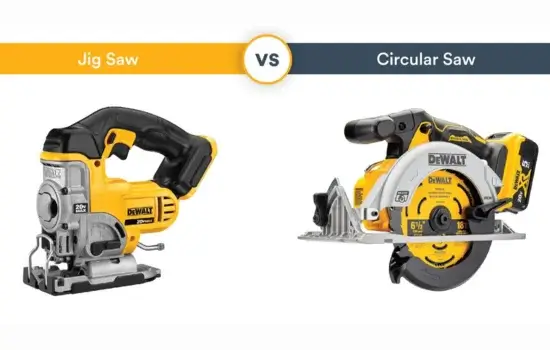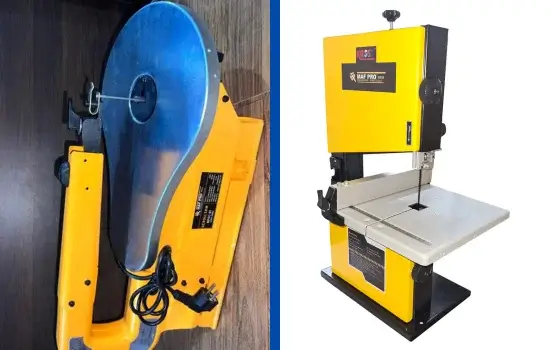For anyone engaged in woodworking, carpentry, or DIY home improvement, choosing the right saw is essential for achieving quality results. Two of the most commonly used saws in these fields are the jigsaw and the circular saw. While both tools are capable of cutting through a variety of materials, they serve distinct purposes and are optimized for different types of cuts.
This article will provide an in-depth comparison between jigsaws and circular saws, covering their functionality, ideal applications, strengths, and limitations, to help you determine which tool is best suited for your needs.
The Definitions: Jigsaw and Circular Saw
Jigsaw
A jigsaw is a handheld power tool designed for making intricate, curved, or detailed cuts. Equipped with a narrow, vertically-oriented blade, the jigsaw uses an up-and-down reciprocating motion that allows it to maneuver through complex patterns and tight turns. It is ideal for working on materials like wood, plastic, and metal, and is especially valuable for cutting shapes and curves that are difficult to achieve with other saws.
Circular Saw
A circular saw is a portable power tool featuring a round, rotating blade that excels at making long, straight cuts. Unlike a jigsaw, which is more delicate, a circular saw is designed for power and efficiency, making it a popular choice for general-purpose carpentry, construction, and home improvement. It is commonly used for rip cuts (cutting along the length of a board) and crosscuts (cutting across the grain of wood), as well as for cutting large panels.
Key Differences Between Jigsaw and Circular Saw
| Feature | Jigsaw | Circular Saw |
|---|---|---|
| Primary Function | Intricate, detailed, and curved cuts | Straight cuts, rip cuts, and crosscuts |
| Cutting Motion | Vertical, up-and-down motion | Continuous rotation |
| Portability | Lightweight, easy to maneuver | Portable but requires more control |
| Cutting Precision | High for curves and shapes | High for straight cuts, moderate for others |
| Cutting Capacity | Limited, typically up to 2 inches in depth | Can handle thicker materials |
| Material Suitability | Wood, plastic, light metal, soft materials | Wood, plywood, and with proper blade, metal and masonry |
| Applications | Craftwork, curved cuts, patterns, scrollwork | Carpentry, framing, cutting large boards |
| Safety Features | Blade guard, variable speed control | Blade guard, sometimes electric brake |
| Cost | Affordable to mid-range | Mid-range to high, depending on features |
Detailed Comparison of Jigsaw and Circular Saw
1. Primary Purpose and Cutting Capabilities
- Jigsaw: A jigsaw is designed primarily for making intricate cuts with precision. It is especially effective for cutting curves, circles, and other detailed patterns. The narrow blade allows for tight turns and controlled cuts, making it a go-to tool for applications that require fine detail, such as crafting, furniture design, and decorative woodworking. While jigsaws can make straight cuts, they excel at cuts that require flexibility and maneuverability.
- Circular Saw: A circular saw is more robust and is intended for making straight, long cuts with efficiency. It excels at rip cuts (along the grain) and crosscuts (across the grain), making it ideal for larger projects where accuracy in straight cuts is essential. Circular saws can also perform bevel cuts by adjusting the blade angle, which is useful in framing and construction work.
2. Cutting Motion and Control
- Jigsaw: A jigsaw blade moves in a vertical, up-and-down motion, which enables it to cut along curves and follow complex patterns. Some jigsaws come with orbital action, where the blade moves in a slight elliptical path, increasing cutting efficiency on softer materials like wood. This movement, combined with the narrow blade, allows for intricate cuts that a circular saw cannot achieve. However, because of this motion, the jigsaw is slower and may require more control to keep a straight line on longer cuts.
- Circular Saw: The blade on a circular saw rotates in a continuous motion, providing a powerful and steady cut. This design makes it well-suited for cutting long, straight lines quickly and efficiently. Circular saws are faster than jigsaws but require steady control to maintain accuracy, especially when cutting without a guide. Circular saws are more challenging to maneuver on curves and are best for straight or slightly angled cuts.
3. Portability and Workspace Requirements
- Jigsaw: Jigsaws are lightweight and easy to maneuver, making them portable and convenient for both workshop and on-site use. Their compact design allows users to cut materials placed on a tabletop or workbench, and they require minimal space. This portability makes them ideal for hobbyists, DIYers, and professionals who need to cut intricate shapes in various locations.
- Circular Saw: Circular saws are also portable but are heavier than jigsaws. They are designed to be carried from site to site and can handle larger materials and more demanding tasks. Although they are portable, circular saws require a stable surface and often benefit from a guide or rail to ensure straight, precise cuts. Their greater weight and power make them slightly less convenient for intricate work, but they are perfect for tasks that require speed and efficiency.
4. Cutting Precision and Complexity
- Jigsaw: The jigsaw is known for its precision on curved cuts, tight turns, and intricate designs. Many jigsaws come with variable speed settings, which allow the user to adjust the blade speed based on the material and the intricacy of the cut. This control makes the jigsaw perfect for scrollwork, crafting, and projects that demand finesse. However, the jigsaw’s accuracy on long, straight cuts can be more challenging to maintain, especially on thicker materials.
- Circular Saw: Circular saws offer excellent precision for straight cuts, especially when used with a guide. They are less suited for intricate work, as their larger blade and high-speed rotation limit their ability to make tight turns. For tasks that require long, straight lines or quick cuts on large materials, a circular saw is much faster and more accurate than a jigsaw.
5. Cutting Capacity and Material Compatibility
- Jigsaw: Jigsaws are generally limited in cutting depth, with most models able to cut materials up to about 2 inches thick. They are versatile enough to handle wood, plastic, soft metals, and other light materials, making them ideal for thinner stock and detail work. However, thicker materials may strain the motor and result in blade breakage, making the jigsaw less suitable for heavy-duty tasks.
- Circular Saw: Circular saws have a much greater cutting capacity and can handle thicker materials, often up to 3 inches or more depending on the blade size and power. They are ideal for cutting plywood, hardwood, and even metal or masonry with the appropriate blade. This capability makes circular saws versatile and able to take on a wider range of projects, from framing and cabinetry to large-scale construction.
6. Safety Features
- Jigsaw: Jigsaws are relatively safe to use, with most models featuring a blade guard that prevents accidental contact with the blade. Some models also have variable speed controls, allowing the user to slow the blade down for intricate work, which can reduce the chance of slipping. Because of the smaller blade and slower cutting speed, jigsaws are generally safer for beginners, although caution is still required when making cuts.
- Circular Saw: Circular saws have safety features like blade guards and, on some models, an electric brake that stops the blade quickly when the trigger is released. However, due to their power and faster cutting speed, circular saws require greater caution during use. The exposed blade and potential for kickback make it essential to use safety glasses, gloves, and proper handling techniques, particularly for beginners.
7. Cost Considerations
- Jigsaw: Jigsaws are generally more affordable than circular saws, making them an accessible choice for beginners and hobbyists. Entry-level models are budget-friendly, while more advanced models with orbital settings, laser guides, and variable speed controls may cost more. The affordability and versatility of a jigsaw make it a good investment for anyone working on smaller or detailed projects.
- Circular Saw: Circular saws range in price, with basic models available for DIY users and high-end models with advanced features like laser guides, depth adjustments, and adjustable speed settings for professionals. While they are generally more expensive than jigsaws, the added power and versatility justify the investment for those needing a reliable saw for more demanding tasks.
Pros and Cons of Jigsaw and Circular Saw
Jigsaw Pros:
- Excellent for intricate, curved, and detailed cuts
- Lightweight, portable, and easy to maneuver
- Safe for beginners, with low risk of kickback
- Generally more affordable, ideal for hobbyists and DIYers
Jigsaw Cons:
- Limited cutting capacity, not suited for thicker materials
- Slower cutting speed, not ideal for large-scale projects
- Less precise for straight cuts, especially on long pieces
Circular Saw Pros:
- Highly versatile for straight cuts, rip cuts, and bevel cuts
- Powerful enough to handle thick wood and tougher materials
- Portable and efficient for on-site and workshop use
- Suitable for large boards and sheet materials
Circular Saw Cons:
- Less precise for curves and intricate work
- Higher safety risks, requires careful handling
- Heavier and bulkier, requiring more control for accuracy
Choosing Between a Jigsaw and a Circular Saw
The choice between a jigsaw and a circular saw ultimately depends on the specific requirements of your projects:
- If your project involves intricate shapes, curves, or detailed cuts, a jigsaw is the ideal tool. It’s perfect for artistic work, crafting, and smaller woodworking projects where precision and maneuverability are essential. The jigsaw’s portability and ease of use make it suitable for DIYers and those with limited space or budget.
- If you’re looking for a powerful tool for making long, straight cuts on large boards or thick materials, a circular saw is the better choice. Its speed and cutting capacity make it ideal for framing, construction, and general carpentry. While it requires more control, the circular saw’s versatility makes it invaluable for large-scale projects and heavy-duty work.
For many woodworking enthusiasts, having both tools is beneficial, as each saw offers unique advantages for different tasks. A jigsaw complements the circular saw by providing the ability to make intricate cuts, while the circular saw covers a broader range of general-purpose cutting needs.
Conclusion
Jigsaws and circular saws each bring unique strengths to a workshop, but they excel in different types of cutting tasks. By understanding the features and capabilities of each tool, you can select the one that best meets your needs, ensuring efficiency, safety, and quality in your work.


